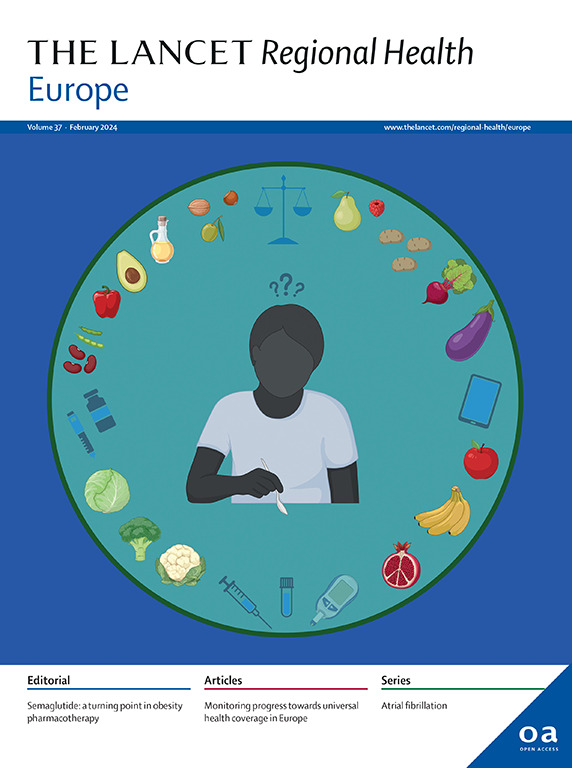Quantifying diagnostic intervals and routes to diagnosis for children and young people with cancer in the UK (Childhood Cancer Diagnosis study, CCD): a population-based observational study
IF 13
Q1 HEALTH CARE SCIENCES & SERVICES
引用次数: 0
Abstract
Background
Childhood cancer is a global disease burden, with early diagnosis a priority. We quantified diagnostic intervals and referral routes for children and young people (CYP 0–18 years) diagnosed with cancer in the UK.
Methods
All CYP diagnosed between September 2020–March 2023 were eligible. Demographic, referral, and symptom data were collected prospectively. Patient interval (PI), diagnostic interval (DI), and total diagnostic interval (TDI) were calculated.
Findings
1957 CYP (mean age 7.4 years, 55% male, 78% white) participated. Median PI, DI, and TDI were 1.1 (IQR 0.1–4.0; range 0–164), 1.7 (IQR 0.4–5.9; range 0–310), and 4.6 weeks (IQR 2.0–11.4; range 0–310), respectively. Intervals were unaffected by sex, ethnicity or deprivation index (IMD). Median TDI was longest in 15–18 years (8.7 weeks, IQR 3.0–17.4) and bone tumours (12.6 weeks, IQR 6.6–23.4) and shortest in under ones (3.7 weeks, IQR 1.0–8.1) and renal tumours (2.3 weeks, IQR 0.9–5.0). 74% (n = 1438) had 1–3 pre-diagnostic healthcare contacts; 67% (n = 1312) presented emergently, with a median of 4.0 (range 0–26) symptoms. CYP with Langerhans Cell Histiocytosis were most likely to have ≥4 visits when compared with leukaemia (adjusted OR 7.48, 95% CI 3.54–15.82), followed by central nervous system, bone, and soft tissue tumours.
Interpretation
This study highlights equal access to diagnosis for sex, ethnicity and IMD, but disparities for age and diagnostic groups. These data will inform professional and public health strategies and health policy to accelerate diagnosis for all.
Funding
National Institute for Health and Social Care Research (NIHR) DRF-2018-11-ST2-055.
英国儿童和青少年癌症的定量诊断间隔和诊断途径(儿童癌症诊断研究,CCD):一项基于人群的观察性研究
儿童癌症是一种全球性疾病负担,早期诊断是重中之重。我们量化了在英国诊断为癌症的儿童和年轻人(CYP 0-18岁)的诊断间隔和转诊路线。方法所有在2020年9月~ 2023年3月诊断的CYP患者均入选。前瞻性地收集人口统计、转诊和症状数据。计算患者时间间隔(PI)、诊断时间间隔(DI)和总诊断时间间隔(TDI)。1957名CYP(平均年龄7.4岁,男性55%,白人78%)参与。PI、DI和TDI中位数为1.1 (IQR为0.1-4.0;范围0-164),1.7 (IQR 0.4-5.9;范围0-310),4.6周(IQR 2.0-11.4;范围0-310)。间隔时间不受性别、种族或剥夺指数(IMD)的影响。中位TDI最长的是15-18岁(8.7周,IQR 3.0-17.4)和骨肿瘤(12.6周,IQR 6.6-23.4),最短的是以下肿瘤(3.7周,IQR 1.0-8.1)和肾肿瘤(2.3周,IQR 0.9-5.0)。74% (n = 1438)有1-3个诊断前医疗保健接触者;67% (n = 1312)出现紧急症状,症状中位数为4.0(范围0-26)。与白血病相比,伴有朗格汉斯细胞组织细胞增多症的CYP最有可能就诊≥4次(校正OR 7.48, 95% CI 3.54-15.82),其次是中枢神经系统、骨骼和软组织肿瘤。这项研究强调了性别、种族和IMD的平等诊断机会,但年龄和诊断群体存在差异。这些数据将为专业和公共卫生战略以及卫生政策提供信息,以加快对所有人的诊断。国家卫生与社会保健研究所(NIHR) drf - 2018-11-11 - st2 -055。
本文章由计算机程序翻译,如有差异,请以英文原文为准。
求助全文
约1分钟内获得全文
求助全文
来源期刊

Lancet Regional Health-Europe
Multiple-
CiteScore
19.90
自引率
1.40%
发文量
260
审稿时长
9 weeks
期刊介绍:
The Lancet Regional Health – Europe, a gold open access journal, is part of The Lancet's global effort to promote healthcare quality and accessibility worldwide. It focuses on advancing clinical practice and health policy in the European region to enhance health outcomes. The journal publishes high-quality original research advocating changes in clinical practice and health policy. It also includes reviews, commentaries, and opinion pieces on regional health topics, such as infection and disease prevention, healthy aging, and reducing health disparities.
 求助内容:
求助内容: 应助结果提醒方式:
应助结果提醒方式:


